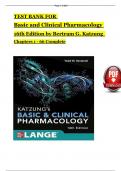Exam (elaborations)
TEST BANK For Katzung's Basic and Clinical Pharmacology, 16th Edition By {Todd W. Vanderah, 2024,} Verified Chapters 1 - 66, Complete Newest Version
- Course
- Institution
- Book
TEST BANK For Katzung's Basic and Clinical Pharmacology, 16th Edition By {Todd W. Vanderah, 2024,} Verified Chapters 1 - 66, Complete Newest Version Test Bank for Katzung's Basic and Clinical Pharmacology 16th Edition Chapters Questions and Answers Download Stuvia Test Bank for Katzung's Basic and ...
[Show more]



